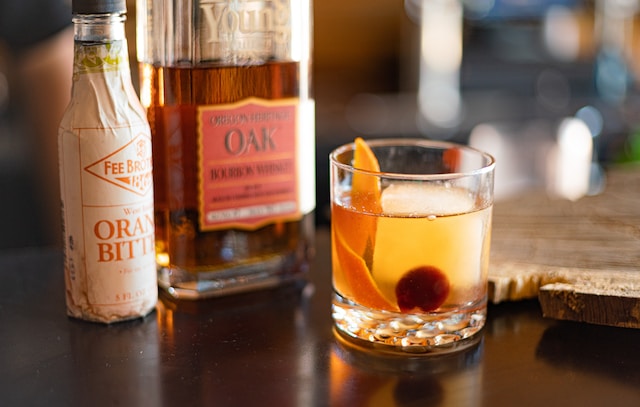Defined as ‘spirits infused with herbs and spices’, bitters as we know them today are popular additions to any cocktail for adding complexity and intense flavor to a drink. In the past, however, bitters have been used for medicinal purposes in several different cultures. Anti-septic qualities, anti-inflammation, and hormone regulation were all once effects associated with the bitters we know now. We’re going to go over a condensed version of the history of bitters and how to use bitters to punch up your favorite classic drinks.
Cocktail Bitters: A Brief History
For centuries we’ve heard old wives’ tales about all the uses for alcohol. Rubbing whiskey on a baby’s gums could soothe teething and using alcohol topically was used as a disinfectant. Interestingly enough, bitters have been proven to hold legitimate medicinal qualities due to their ability to extract compounds from various plants. Burdock bitters can be used to aid in gut health, for example. People still use bitters today as a way to relieve a variety of ailments.
One of the most notable instances in history of the use of bitters came from a doctor by the name of Johann Siegert. In 1820, Siegert became the surgeon general under the army of the great Simon Bolivar, an anti-colonialist military leader that lead the liberation movement against the Spanish for a large portion of the South American countries we know today. Angostura bitters came about as a general aid for afflictions ranging from seasickness to malaria symptoms, eventually becoming a popular export in the 1850s as its medicinal qualities became widely recognized. It’s speculated that bitters got their name from the distinct bitter flavor of Angostura bitters. Today, Angostura is still exported with the company’s headquarters located in Trinidad and Tobago. You can still use the centuries-old remedy in your drinks and as a means to treat your conditions.
Around 1840, another prolific figure emerged in New Orleans. Antoine Peychaud began selling a cure-all herbal remedy under the name Peychaud’s bitters. Made from a variety of roots and medicinal seeds, Peychaud’s bitters were meant to be added to a toddy, which included water, sugar, brandy, and his signature bitters. Peychaud’s creation helped usher in a new era of cocktails as his bitters became a popular addition to several different mixed drinks.
Now that bitters have transitioned from being a popular remedy for a variety of ailments into a tasty addition to your favorite cocktails, bitters are being made from anything and everything. Coffee, chamomile, strawberry rhubarb… you name it and it could be made into bitters. Bitters aren’t too difficult to make (you can even make your own at home!) and can be an interesting addition to any cocktail.
Easy Drinks With Bitters to Update Your Cocktail List
Bitters are still a key part of some classic cocktails. You can never go wrong with the old favorites, choosing some cocktails that feature bitters is a great way to make your cocktail menu more robust without creating all new drinks.
- Old-fashioned. An old-fashioned contains whiskey, water, sugar, Angostura bitters, and an orange peel. The bitters in this instance will help enhance the flavor of the whiskey, giving it depth, complexity, and aromatics. This makes for an interesting yet classic flavor profile for this cocktail.
- Whiskey or gin with bitters. Adding a dash of bitters to plain gin or whiskey works similarly to how it works in an old-fashioned. Bitters do an excellent job of adding something unique to whatever you put it in, allowing you to taste different parts of the whiskey you might not have been able to taste before. It’s a simple yet transformative trick to elevate your liquor. This can be fully customizable as well, don’t be afraid to experiment with different types of bitters.
- An “original” martini. The martini we know today is made with gin, vermouth, and an olive or twist of lemon. A classic martini, however, contains orange bitters. The addition of the orange bitters harmonizes well with a twist of lemon and highlights the dryness of a martini. It’s not recommended to have olive with this type of martini, however, as the orange bitters can give the martini an odd taste.
- Manhattan. Yet another classic drink that uses our favorite cocktail flavor enhancer, a Manhattan is made with whiskey, sweet vermouth, and Angostura bitters. You can experiment with the bitters as well for some new flavors. Orange bitters go well with the warm, spiced flavors often associated with whiskey. Maybe you’d like to try a Manhattan made with chocolate bitters, bringing a unique, dark chocolate flavor to the drink. Some have even experimented with celery bitters, claiming it brings a fresh, bitter flavor that completely changes the drink.
- And more! Since bitters are so diverse, you can easily find bitters that enhance any number of your favorite cocktails. The aromatic quality of bitters allows you to punch up the flavor of nearly any drink. Think of it like seasoning your food before you cook it, that little bit of bay leaf or parmesan rind really adds something to what you’re making. There are endless possibilities for the bitters you can use so feel free to go a little crazy and try something new!
Keep Track of All the Fancy Bitters in Your Rotation With Provi
Provi’s all-in-one inventory tracking and ordering system allows you to keep tabs on your bitters and restock them as needed. If you’re looking for something new, you can check our catalog containing thousands of options from a wide variety of your favorite distributors. If you’re interested in seeing how you can condense your inventory and ordering into one convenient place, check us out today and sign up for your free account. You could make an order in as little as 5 minutes.



Comments